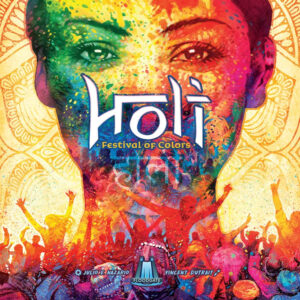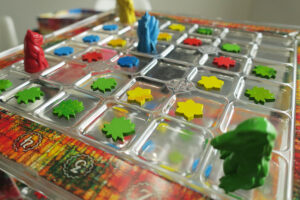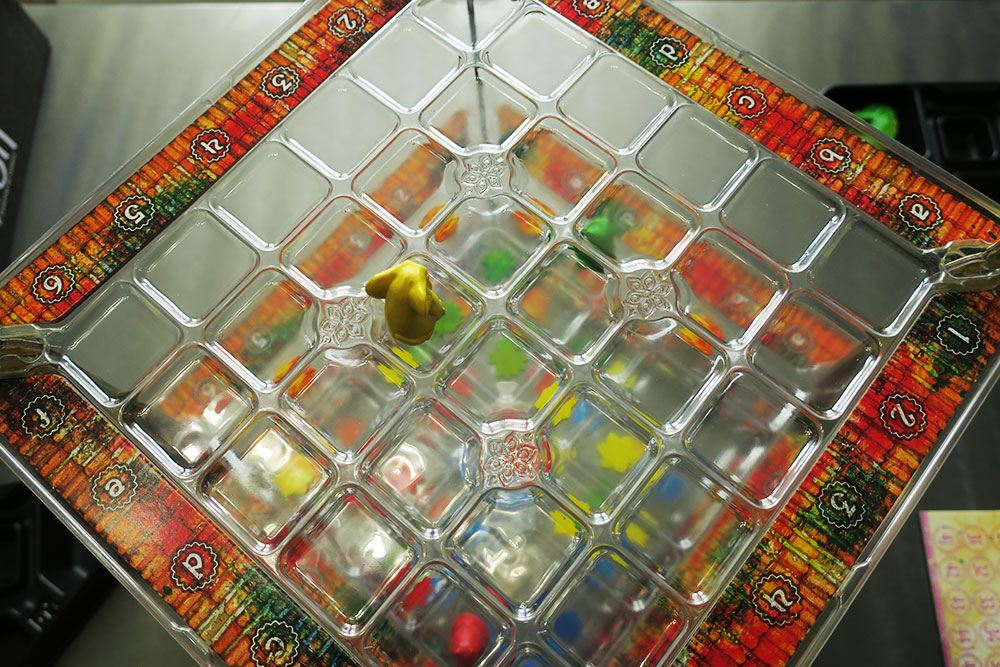 Holi, known as the Festival of Colors, Festival of Spring, and Festival of Love, is an Indian holiday celebrated each year. While it seems to have a lot of ties to different Hindu legends, there is an overarching theme of goodness, joy and ending conflicts. I don’t know about you, but I think the world could use more of this. Maybe take some time today to do a little bit of good. Anyway, onto a game!
Holi, known as the Festival of Colors, Festival of Spring, and Festival of Love, is an Indian holiday celebrated each year. While it seems to have a lot of ties to different Hindu legends, there is an overarching theme of goodness, joy and ending conflicts. I don’t know about you, but I think the world could use more of this. Maybe take some time today to do a little bit of good. Anyway, onto a game!
Holi, published by Floodgate Games and designed by Julio E. Nazario, plays two to four players in about 30 minutes.
Gameplay Overview:
Players will be recreating the experience of Holi by spreading color, mischief, and joy. You’ll be scoring points for throwing color tokens on the board and your opponents. There are Rivalry cards that can be added to the game to create more scoring opportunities, as well as modify the rules for your game. The game ends when all players run out of their cards or color tokens. The player with the most points at the end wins.
On your turn, you’ll take the following actions in any order you wish:
Throwing Color (mandatory), Move, and Climb Up (both optional).

Throwing Color is playing a card from your hand either face up or down. If you play it face down, place one color token anywhere on your current tier that doesn’t have a color token or Player Marker. You can do this every other turn if you like. When playing it face up, two or three tokens are placed according to patterns shown on the cards. Your Player Marker must occupy one of those spaces (usually) and if you manage to hit your opponent in the pattern, it’s worth some extra points. You’ll have the flexibility to turn the card around any which way you want to place those tokens; you just have to be able to lay the pattern out fully, so no running over the side of the board.

Move allows you to put your Player Marker on any space within your current tier. You can land where there are color tokens, which you’ll pick and add to your supply. Unless it’s your opponent’s, in which case they’ll score some points. There are also Sweets tokens set out at the beginning of the game which you can pick up. While these aren’t worth anything on their own, at the end of the game, players will total the Sweets they captured. Every player that has less than you will earn you five points. Moving may also let you Climb Up.
Holi’s board is made up of three levels. Whenever your Player Marker is surrounded orthogonally by color tokens and there isn’t a player directly above you, you can move up one tier. But once you go up, there’s no going down. So why climb up? Color tokens score more points the higher up the board they are. Tokens on the ground level score one point, up to three on the top tier. But this is where it gets interesting. When a player throws color on a higher tier, the tokens fall to lower tiers unless there is a token below it. They can even fall to hit another player, which scores you points.

Game Experience:
Holi is an easy game to teach. Don’t let the board trick you into thinking it’s introducing 3D Chess. It’s not. That would be 3D Chess. Once you’ve gone through learning the game, included are some handy player aids for reference that will keep your first game running smoothly. Everything a player needs to know is spelled out, so it’s very accessible.

Strategies and focus will change each game depending on the player count and Rivalry cards. With two players, it’s fun and enjoyable, but there is a lot less interaction than with more people. The friend I played against didn’t get to the top tier with me until the second to last turn and when I did throw color and hit him, he was never on the same tier as me. In fact, we mostly went about our game without interaction. That’s not to say the same would happen for you; it all depends on your opponent, right? My preference? The more, the merrier. Things like the Sweets tokens will play more of a role too if there are more players. If you have the most in a two-player game, it’ll only get you five points versus a possible fifteen if you have all four people playing.
The Rivalry cards can change those dynamics of the game too. Part of the reason my friend didn’t meet up with me until the end of the game was due to being focused on getting points from one of the Rivalry cards. It’s what pushed him to the win and influenced how he decided to play. They add variety that I think will give Holi a bit more longevity and fresh feeling than it would have had otherwise. They are optional to use, so you don’t necessarily have to integrate those on your first game. But I would venture to guess after that first one where you feel comfortable with playing the game, they’ll get added in.

Holi has a wonderful table presence. It caught the attention of some people who stopped to ask what we were playing. How often do you see something that rises up off the table? It’s quite unique in that regard and it doesn’t hurt that it’s attractively colorful either. Speaking of looks, there is a regular and premium version available to buy. While these are mostly material differences that most people won’t care about, the premium includes some really nice Game Trayz that speed up getting components out and the game set up fast. I know not everybody will care about this, but when the cost difference between buying the standard and premium is the same as buying the Game Trayz after the fact, it’s something to consider if you’re buying a copy. I would recommend the premium copy just for the ease of setup and storage.
Final Thoughts:
Holi: Festival of Colors ticks a lot of boxes for me. It looks good, plays and scales well, and has a nice variety that will keep it from getting stale. Were it not for the Rivalry cards, Holi could have been firmly in the “fine” category, so definitely use those to change things up. I’m always on the lookout for a solid abstract strategy game and this didn’t disappoint. While I may not keep Holi: Festival of Colors forever, few games get that treatment if I’m honest, it’s a really enjoyable game that I think will, like the holiday, spread some joy.
Final Score: 4 Stars – An eye-catching abstract that spreads strategy and joy
 Hits:
Hits:
• Unique table presence
• Rivalry cards and scalability with players keeps the game fresh
• Easy to teach and easier to set up with the Game Trayz
Misses:
• Playing at two isn’t as interactive as with three or four






















